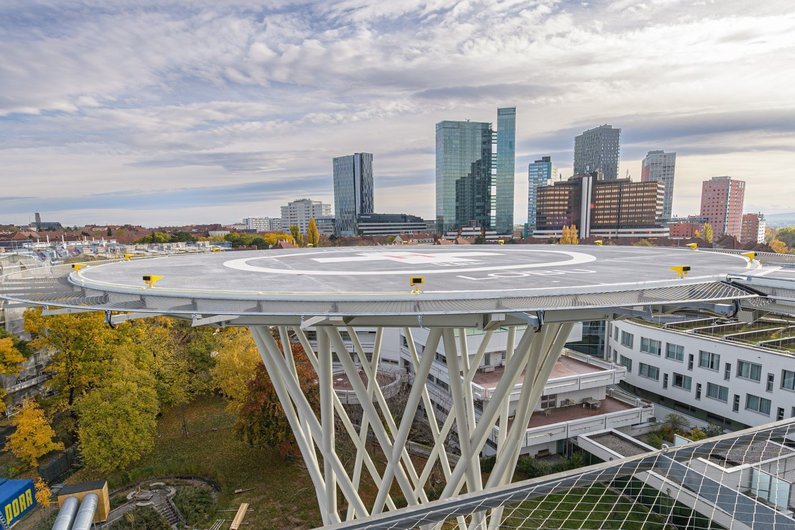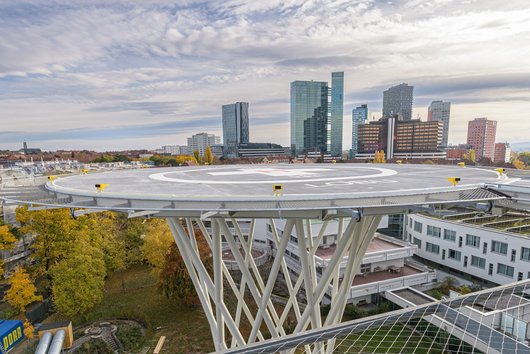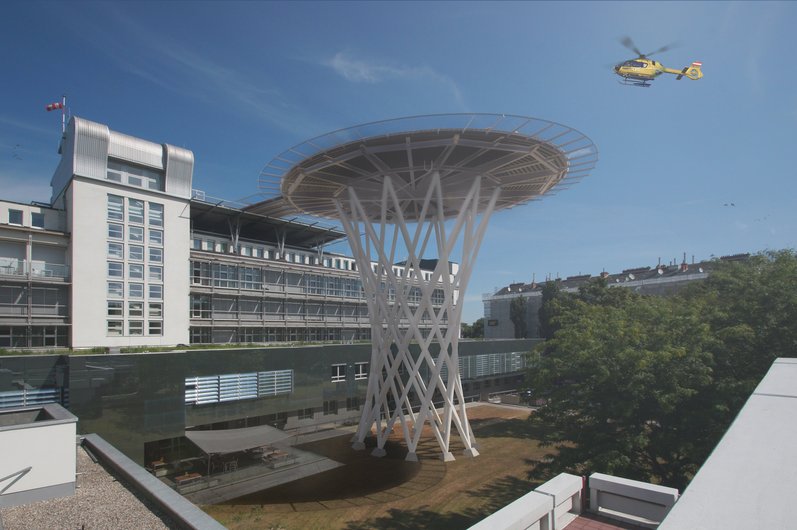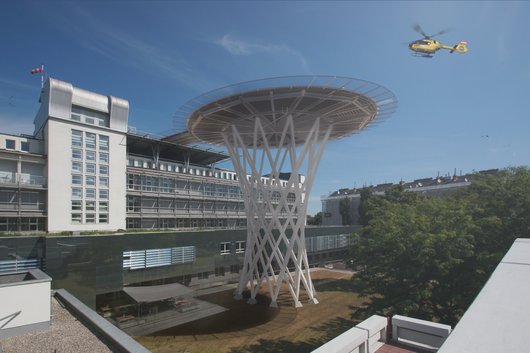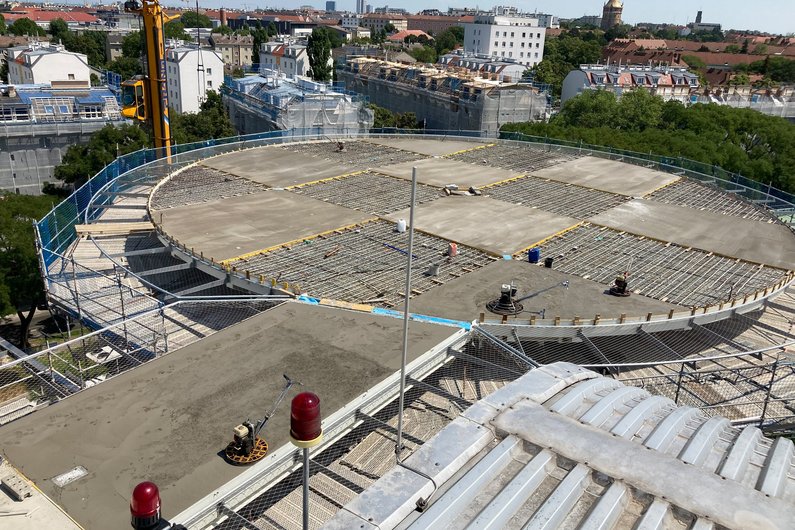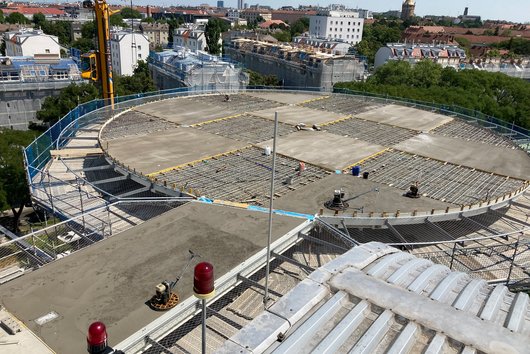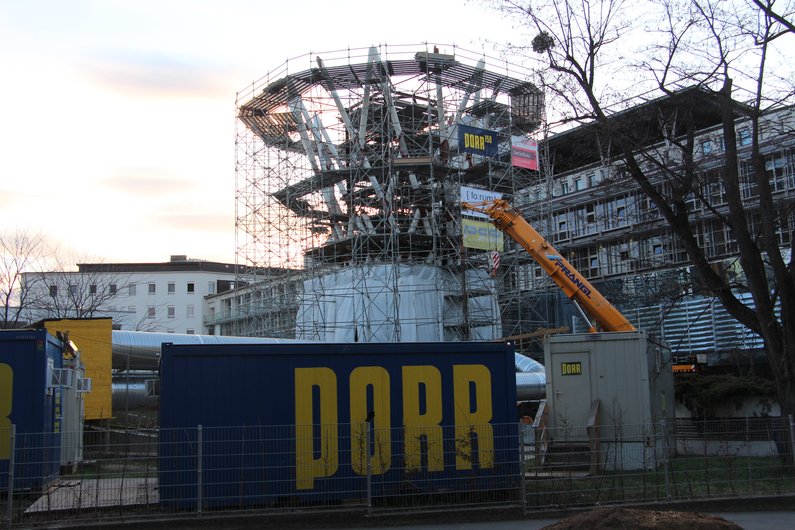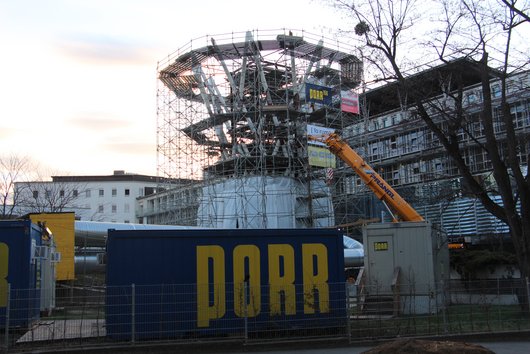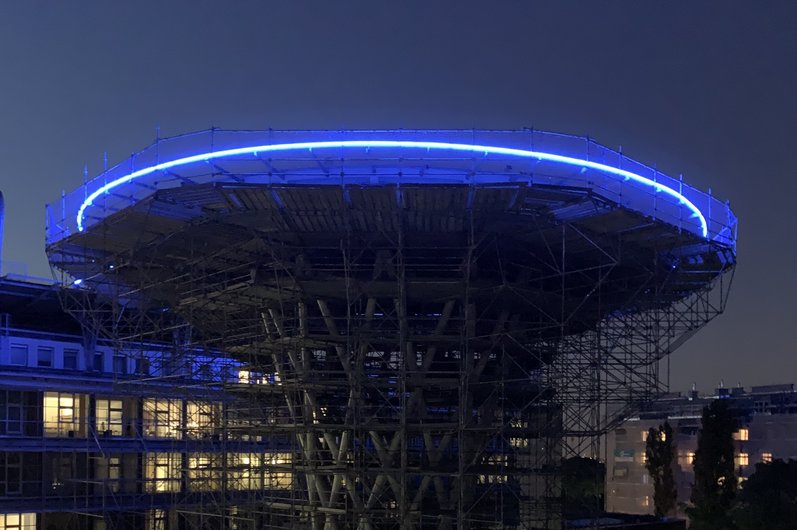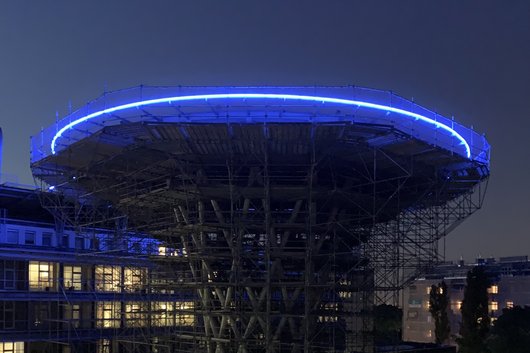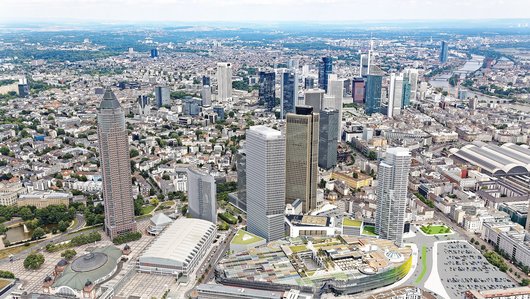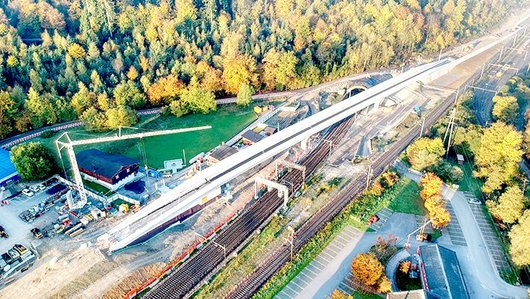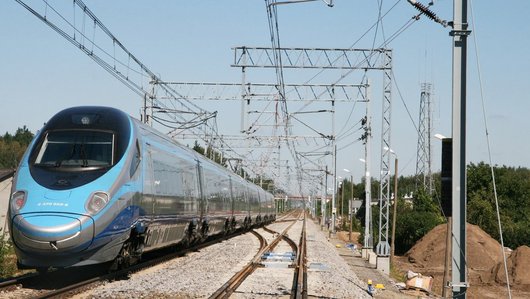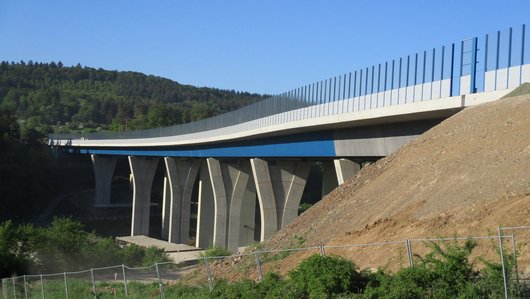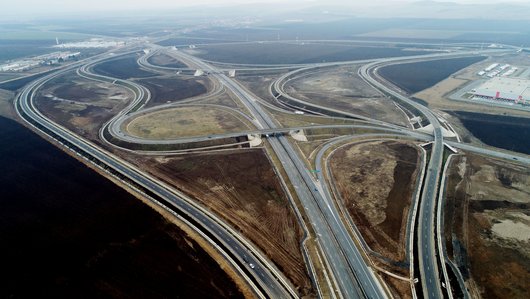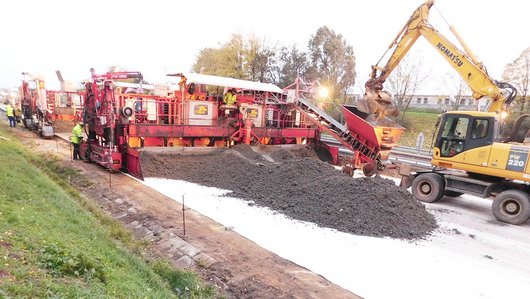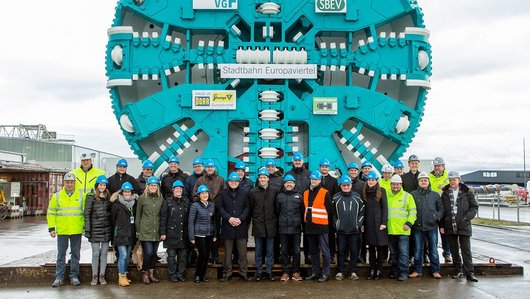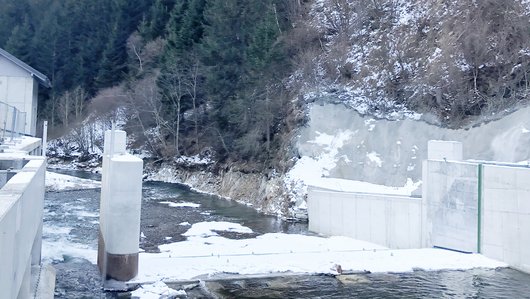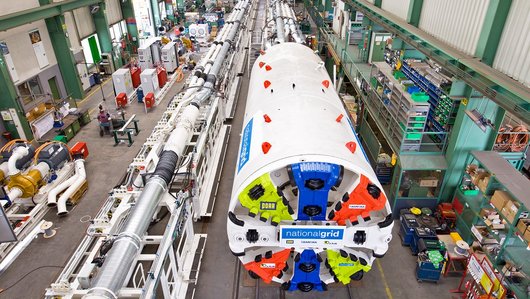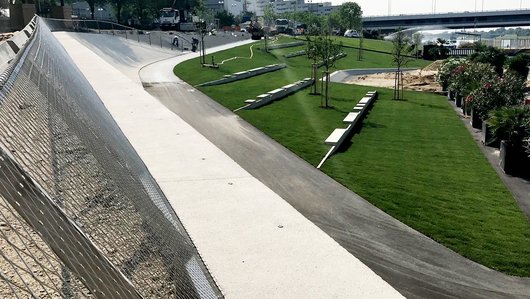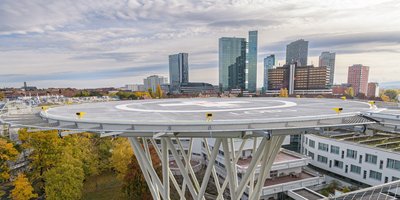
Helipad at Meidling Trauma Hospital
For the Meidling Trauma Hospital in Vienna, multiple PORR departments worked closely together to build a new helicopter landing pad.
A tubular steel landing pad in the form of a double helix – that’s not something you build every day. The special project was a challenge through and through, from the design to the production of the prefab parts to the assembly. Erecting the scaffolding was also exceptionally complex. But in the end PORR successfully realised this construction project by applying its knowhow and experience.
-
EmployerAllgemeine Unfallversicherungsanstalt AUVA
-
ContractorPORR Bau GmbH
-
ArchitectFORUM – Architekten + Ingenieure ZT GmbH
-
Order typeGeneralunternehmer
-
Project typeCivil engineering/infrastructure/structural engineering
-
Project scopeConstruction of a 26m-high helipad as a tubular steel double helix
-
Order volumeEUR 3.2m
-
Construction start2020
-
Construction end2021
Cross-departmental collaboration
The old helicopter landing pad on the roof of the Meidling Trauma Hospital was no longer fully compliant with the updated legal requirements. The expansion and reinforcement that would be required was not possible for structural reasons. That is why the Allgemeine Unfallversicherungsanstalt AUVA decided to build a new, freestanding structure in the form of a tubular steel double helix, linked to the trauma hospital via a bridge.
The technical lead on the project was the steel construction department of PORR Bau GmbH. Also involved were the railway and structural engineering departments, specialist civil engineering, IAT and ELIN. The contract was worth EUR 3.23m.
Stringent requirements
PORR’s scope of services included the detailed planning for the steel construction as well as the manufacture and assembly of the helipad as general contractor. For the assembly planning, every stage was statically calculated and sketched in order to assess the forces and strains in detail. The centrepiece of the project is the double helix composed of welded steel tubes. It not only had to meet the highest static requirements, but also be easy to assemble. For this purpose, so-called ladders were produced in the factory using templates specially developed for this project. These ladders were delivered to the construction site by special transport and slotted into position with a mobile crane. Afterwards, the individual ladders were linked together with fitted pipe segments, the so-called filler rods.
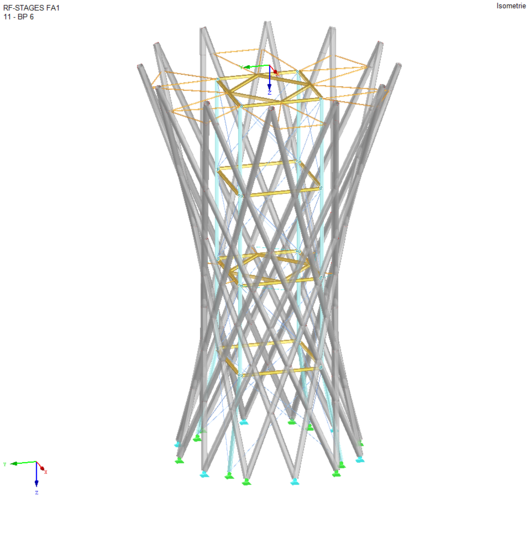

In order to deal with the deformations during the construction phase, we used special longitudinally adjustable connections to the central assembly tower, known as braces.
Fragile construction phase
While the double helix is a structure that is extremely rigid in all directions in its finished state, it was quite fragile in the construction phase. The spatial alignment of the ladders in the same direction caused large deformations and a twisting of the centrally positioned assembly towers. To control this, braces were used, i.e. longitudinally adjustable connections to the central assembly tower. They were adjusted so that the filler rods of the double helix could be installed without tension. This meant that the geometry could be realised as planned. After an extensive variant study, the helix was erected in two storeys because a ladder element with a total length of 30m has very large deformations while being assembled and would have been very difficult to control on the construction site due to the three-dimensional geometry.
Multifunctional platform
A bolted platform that was rigid in radial and tangential directions was placed on the welded double helix. The node configurations and tolerances had to be selected in such a way that, on the one hand, the boundary conditions from the statics and the execution standards were met, while also facilitating quick and simple assembly without reworking on the construction site. The option chosen was a pin connection at the total of twelve contact points between the double helix and the platform.
The radial beams were attached to a central ring in the centre of the platform. A butt strap joint allows both the transfer of the bending moments that occur and compensation of the geometric tolerances by utilising the existing hole clearances. The radial and tangential rows of girders were connected by means of headplates. The safety net was also attached to the edge girder running all around. This was necessitated by the fact that vertical railings are not possible on the helipad. The bearings of the connecting bridge are designed in such a way that the complete helipad can move independently of the existing structure even in the event of an earthquake. The entire double helix was given a fire-protection coating. At the outermost edge of the platform, we installed effect lighting to ensure the structure is also illuminated at night.
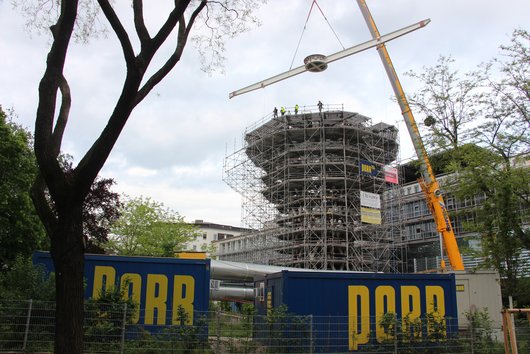

The platform’s drainage system is architecturally inconspicuous, running along a strand of the double helix down to its foundations. The drainage is also designed in such a way that in the event of any damage to a helicopter, any jet fuel that may spill is drained off via the pipe and collected using separators built into the foundation.
A reinforced concrete slab with permanent formwork is tied to the platform girders. This consists of a primary concrete slab connected with head bolt dowels and several floating secondary concrete slabs. A bituminous seal is applied over the primary concrete. This is where the residual water that cannot be drained off at the top level is discharged. The secondary concrete contains a layer with heating pads. This heated layer ensures that no snow settles on the platform and that the surface is always de-iced. The secondary concrete also contains drainage gullies, beacons, temperature sensors and lightning-protection devices.
Complex scaffolding
The design and installation of the scaffolding posed a special challenge. An internal scaffold tower was necessary to attach and set up the ladder elements. To ensure access to every single point of the double helix as well as for the assembly of the platform, an additional external scaffold with a height of 25m and a diameter of 36m had to be erected. Erecting a double cantilever scaffold was also something out of the ordinary for the scaffolding company carrying out the work, albeit absolutely necessary due to the cramped conditions.
The scaffolding had to be planned in terms of the plateau levels and footprint so that the complex three-dimensional geometry of the double helix did not collide with the straight system scaffolding. Because the octahedron base of the scaffolding was one of the first jobs to be started and then extended step by step with the installation of the ladders, the accessibility for the assembly of the steel structure, the welding sequence and the site corrosion protection had to be planned in its entirety before assembly even began.
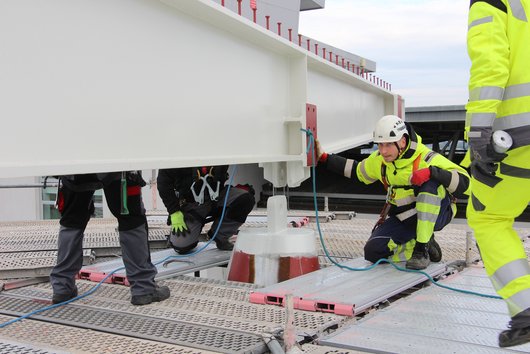

An internal scaffold tower was required for attaching and setting up the ladder elements. An additional external scaffold was needed so we could access every single point of the double helix and assemble the platform.
Conclusion
As scheduled, the helipad was operational in the third quarter of 2021. Dismantling the scaffolding took around two months and was completed in October 2021. Thanks to the excellent cooperation of several PORR departments, the contractually agreed date for the overall completion was met.
Technical data
-
Height26m
-
Max. diameter double helix16.5m
-
Min. diameter double helix8m
-
Landing area750m²
-
Outer diameter landing area28m
-
Outer diameter safety net32m
-
Verbauter Stahl200t
-
Verbauter Beton200m³
-
Verbauter Betonstahl30t
-
Driven piles60

